Hunting coyotes with a shotgun is the perfect way for a beginner to try out the sport. Its cheap and reliable 12 gauge shotgun will work. It’s effective up to 50 yards. And it works for every method of attracting coyotes, from calling to using bait piles.
Using a shotgun to hunt coyotes allows a new predator hunter to target coyotes that suddenly appear too close for a scoped rifle, engage coyotes approaching from behind, and take coyotes faster than a bolt-operated weapon.
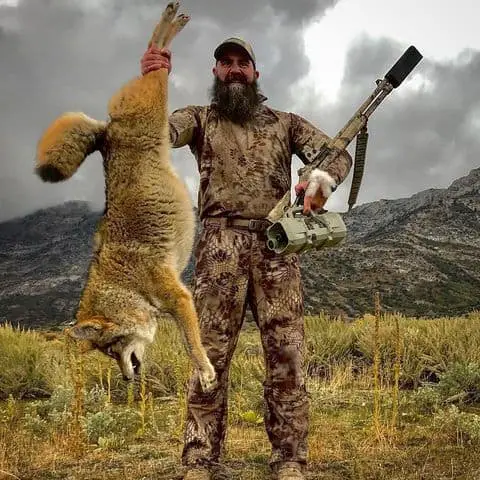
Mind you; I said ”beginner.” Tom Austin (pictured above) has years of experience, and he has honed the skills needed for running both guns and cameras. On top of that, his equipment is expensive and designed for coyote hunting. You can learn more about Mr. Austin on Instagram at @Predatorstrikeforce.
Coyote hunting beginners should not spend additional funds on expensive weapons, fancy sights, or high-end ammunition. At best, all three may increase your range by 25 yards. At worst, you will try to shoot at coyotes too far away, spend less time learning how to call coyotes effectively, and waste your hard-earned dollars on a sport you don’t find interesting.
Ethical values: Your best tool when hunting coyotes with a shotgun.
As a first-time coyote hunter, the best thing you can do for the continuation of the sport and to ensure your enjoyment of it is to commit to a personal standard of behavior that exceeds that of mere compliance with the law.
That’s a long sentence, but what does it mean? At its root, it means taking only ethical shots. And ethical shots for you are going to mean waiting for that coyote to get very close.
Shooting a shotgun at a coyote 75 yards away is unethical for 99% of all of even the most experienced and skillful predator hunters.
As for you, depending on the shotgun and ammo you will be using, 20-35 yards should be your maximum range.
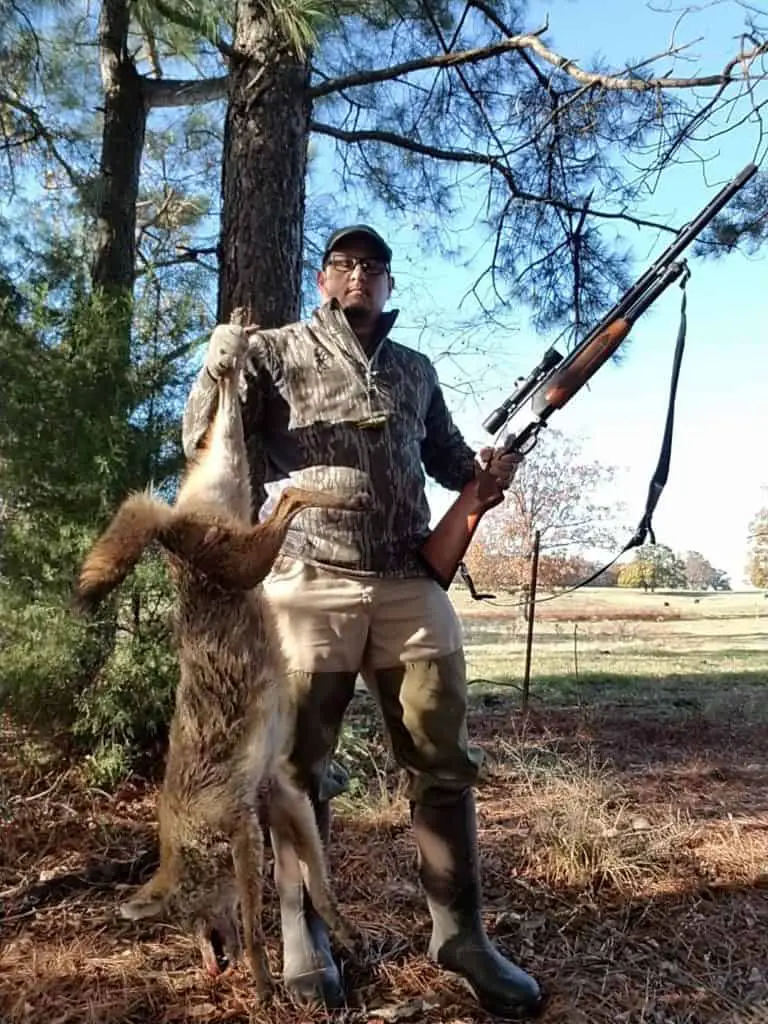
Tip #1: When hunting coyotes with a shotgun, your goal is a dead coyote.
This will be the hardest thing you do when hunting coyotes, but you have to aim at the coyote’s vitals, wait until it is within range of your weapon, and only pull the trigger when your sites have settled, and your background is safe.
You’re not out in the woods to shoot at a coyote. Your objective is to become a skilled predator caller and a precise marksman. You are there to test your maturity level. Do you know how to read a coyote’s body language and adapt your calling routine in response? Do you have the patience to wait until the perfect moment to take your shot? Do you genuinely believe your best coyote hunt will always be the one you let the coyote get away without a firing on?
DRT or Bust: The attitude of the best coyote hunters.
The goal of every shot must be to produce a dead right there (DRT) coyote. An ethical predator hunter doesn’t take a poor percentage shot at a coyote. And an ethical coyote hunter also commits to tracking down a wounded coyote and humanely dispatching it—regardless of the time and energy required.
Wounded coyotes can cause the sport a lot of expected and unexpected problems. A few pictures on social media of suffering coyotes limping down the road or wandering through local playgrounds with severe head wounds could end the sport in your state soon.
And wounded predators have been known to remain near farms with livestock. With limited hunting abilities, injured coyotes are now forced to haunt these farms. A wounded coyote is desperate, unpredictable, and impossible to scare off.
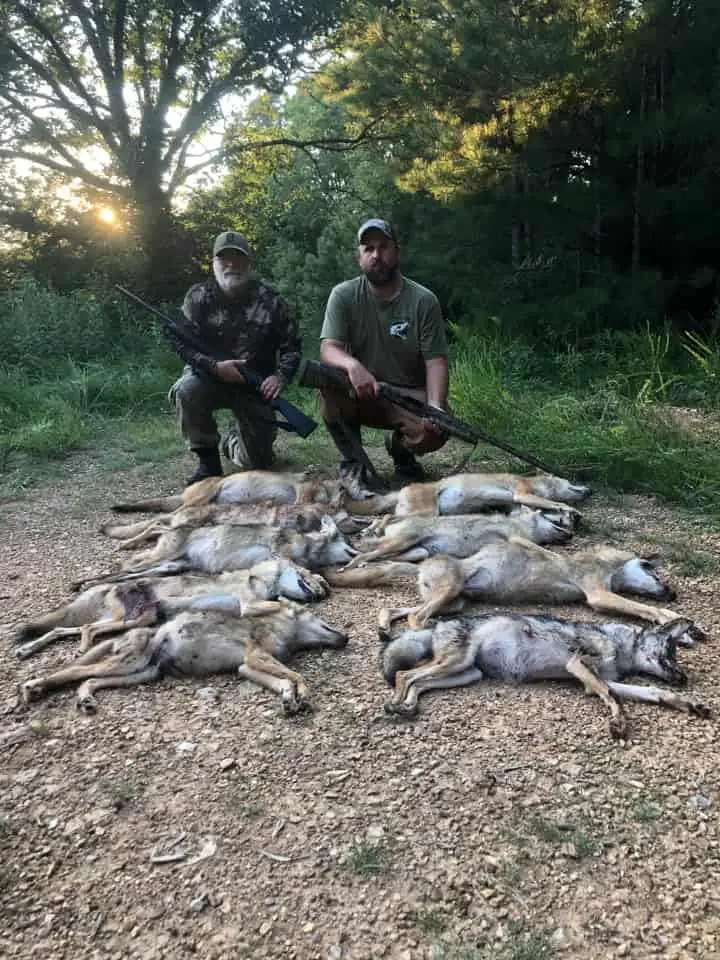
Tip #2: Know why your shots miss when coyote hunting with a shotgun.
There are three reasons you might miss a coyote, even one standing still a 10 yards away.
- Fear of recoil. Until you have developed the “muscle memory” always appropriately needed to shoulder a shotgun, you will take a few painful shots. A bruised shoulder and a swollen cheek heal quickly, but the memory of the pain lingers for a while.
- Adrenaline. Hunting coyotes with a shotgun will be one of the top ten most exciting things you will ever do in your “modern” life. The adrenaline dump will spike your heart rate, make your shoulders shake, and wobble your front site around.
- Doubt. The minute the coyote shows up, you’ll be second-guessing everything. Suddenly, you doubt everything from how much closer the coyote will get before running off to the pattern your shotgun made at the range.
There’s only one way to eliminate all three reasons why you might miss; realistic practice.
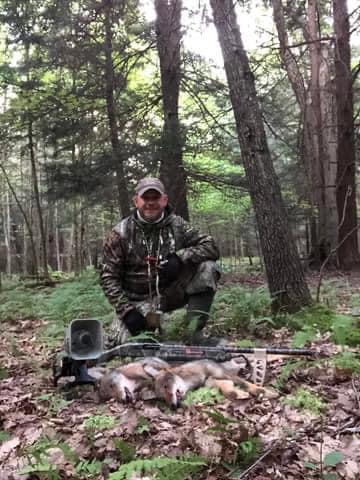
Tip #3: Realistic practice improves your skills for hunting coyotes with a shotgun.
Realistic practice will conquer the fear of recoil, adrenaline rush, and doubt. It will teach muscle memory, reduce the effects of excitement, and convince you your tools and abilities will perform in the field the same as they did on the range.
Realistic practice requires time on the range and lots of rounds perfectly placed on a paper target.
Patterning a shotgun for coyote hunting doesn’t mean counting the number of hits on a 30” circle. Instead, it means consistently putting the proper number of pellets in an 8” circle (the coyote’s vital zone) at a known distance.
Related: Read my article on where to shoot a coyote.
Shotgun practice tips for new coyote hunters.
After you have properly patterned your shotgun, it’s time to simulate the adrenaline rush.
There are two ways to artificially simulate adrenaline.
The first and most straightforward method is to add the element of a time constraint. Set up two targets and take one shot at each within two seconds. On your first target, take a well-aimed shot, then instantly swing to get a second one and immediately take your shot.
Keep repeating this method until your second shot produces a consistent dead right there pattern.
The second method of replicating the adrenaline rush is doing a minute or two of exercise before you shoot. A few minutes of jumping jacks or a quick jog should increase your heart and breathing rates enough to match your body’s reaction to the appearance of a coyote in real life.
While either one of these will help you learn how to combat the effects of adrenaline, combining both will help you master them. Once you know you can accurately shoot despite the time allowed and the elevated physical response, you are ready to begin hunting coyotes in the real world.
Tip # 4: The best coyote hunting shotgun for a beginner?
The importance of spending zero dollars cannot be overstated. If you already own a 12 gauge, pump-action shotgun, you probably do not have to invest further. I recommend you check your current shotgun out for the following:
- Is it in a safe condition to shoot? If in doubt, at your level of experience, take it to a gun store and have the armorer evaluate its condition.
- Is the barrel 18 inches or longer? A shotgun with a 14” barrel will severely limit your range (think 15 yards or less). If you have an 18” barrel, will it take a choke? We’ll discuss chokes in a bit, but for now, an 18” barrel will need a choke for anything over 30-40 yards. Barrel lengths over 26” are unwieldy in the terrain commonly found during coyote hunting. If your barrel is between 20-26 inches, it is perfect.
- Does it have a stock? Some home defense shotguns do not come with a shoulder stock—these weapons are unsuited for coyote hunting at the entry-level.
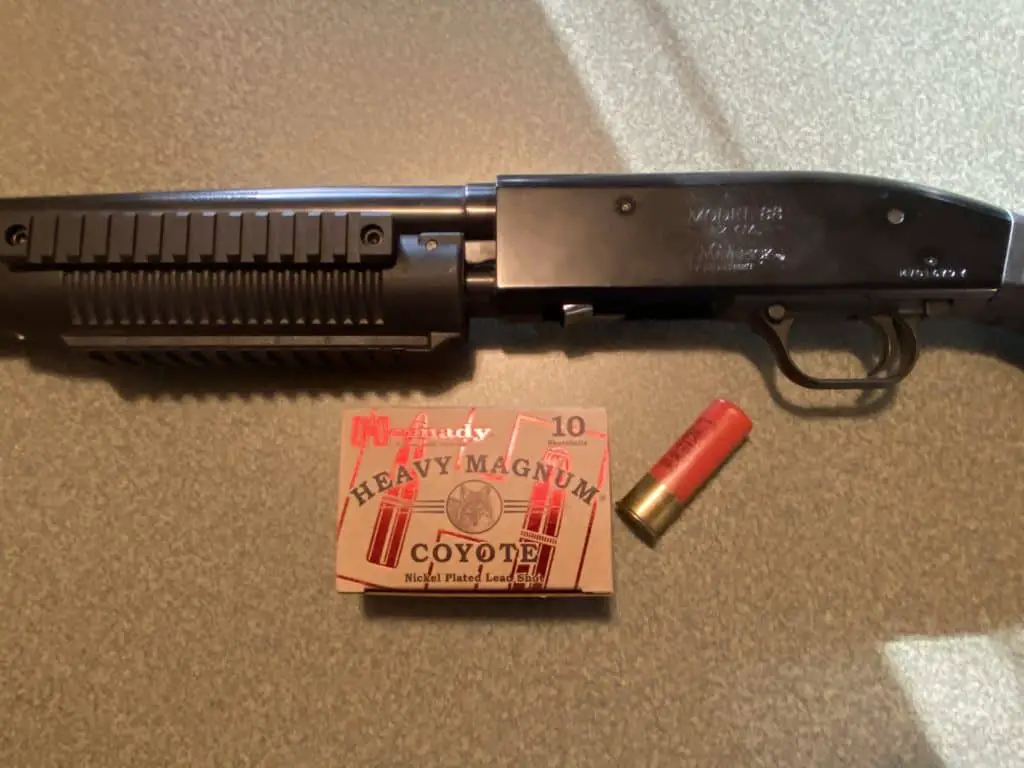
Using a home defense shotgun for coyote hunting.
Trust me, every ”real” coyote hunter spilled their Monster energy drink reading the above caption. And, in all honesty, they have a reason.
My home defense shotgun, a Maverick 88, sports a 20” cylinder bore barrel. That means it does not have a choke and is not designed for regular hunting.
However, I use my Maverick 88 to hunt coyotes in dense woodlots and frequently at night. Coyotes often make their first “shootable” appearance as rapidly moving targets at ranges under 20 yards. A running coyote charging straight toward my position and veering off to the left or right upon busting me calls for some fast gun action.
As we will see below, you can quickly get a coyote to approach within 20 yards. In fact, 5-10 yards in the woods is a typical shooting range (albeit, your target is often hauling butt to get away).
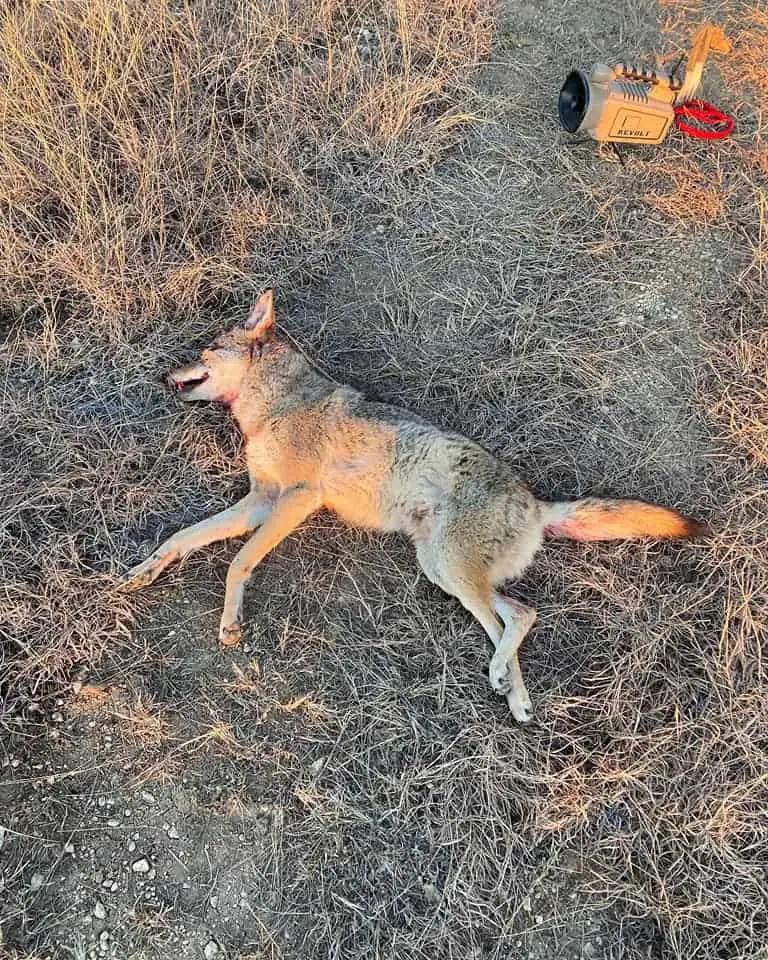
Tip # 5. The perfect pattern for hunting coyotes with a shotgun.
So many articles on how to pattern a shotgun have you using a paper target with a 30” circle drawn on it. I’m not sure that’s helpful, let alone realistic.
To simplify things, I suggest you buy a three pack of life-like coyote targets like this one:
Now pattern your shotgun until you can consistently put at least 5 of your pellets in the vitals zone, if using # 4 buck.
If you think you’ll be shooting further than 35 or more yards, make sure you can put at least 40% of your pellets in the same zone. At greater distances, a more significant percentage of the shot hitting in the right place will be needed to anchor your coyote to the ground.
Do you need a choke for a coyote hunting shotgun?
A shotgun choke is a metal constriction device you screw into the end of your barrel. The choke controls the spread of the pellets. Only one thing determines which choke you should use: the distance to your target.
You need a choke if you want to put down a sizeable eastern coyote at 50 yards humanely. I suggest you use a modified choke if your shotgun accepts one. If you want to go fancy and buy a choke made specifically for predator hunting, Carlsons is your best bet.
Before you buy a choke from Amazon, check the product description to confirm it fits your type of barrel. Also, read any warnings about what kind of shotgun ammo you can use with your choke.
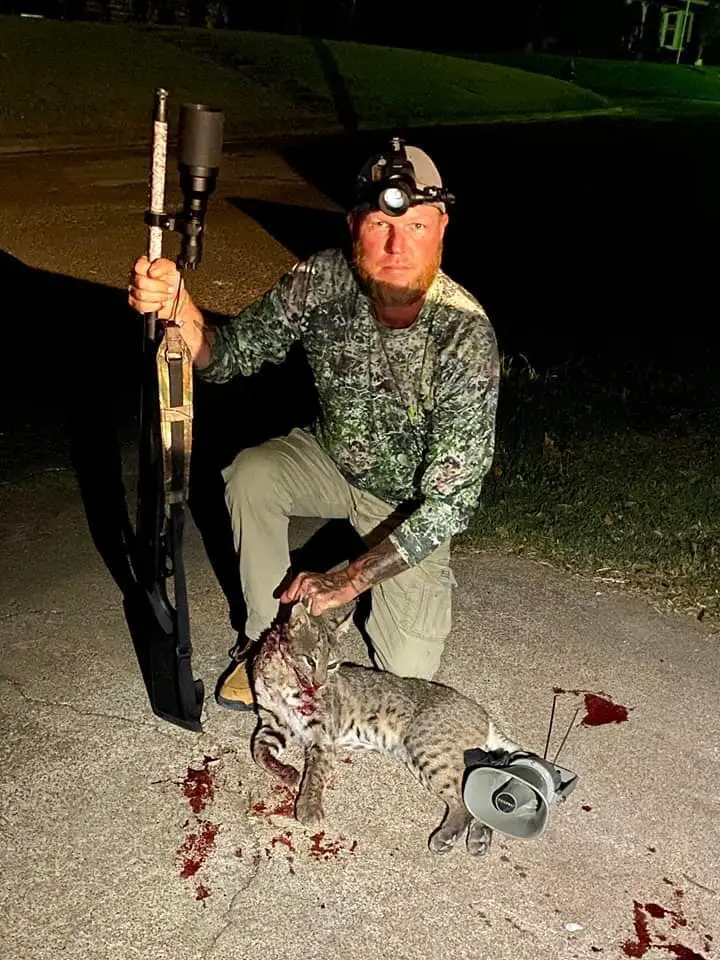
The best 12 gauge shotgun shell to use when coyote hunting.
What is the best shotgun round to use when hunting coyotes? Well, I’m just a writer. My opinion and experience are limited. I do, however, have a lot of friends who possess superior skills and more remarkable experience than I—and I asked them that same question.
Here’s what a few recommended: as a new coyote hunter out with a shotgun for the first time
Author’s note: Throughout this article, photos and comments were provided by a variety of hunters. Their inclusion in this article does not mean they even come close to agreeing with anything I have to say. Any errors are mine.
Erick Trombly, owner of Fuel the Heritage, a Climax, Michigan outdoor sporting goods company, uses the Hevi-Shot Dead Coyote.
Kevin Rought is the owner of Tools of the Trade, a Michigan Class 01 FFL that provides services including Duracoat refinishing, parkerizing, trigger work, scope installation, and troubleshooting. Mr. Rought shoots Hornady Magnum Coyote in 00 during the day, but BB at night.
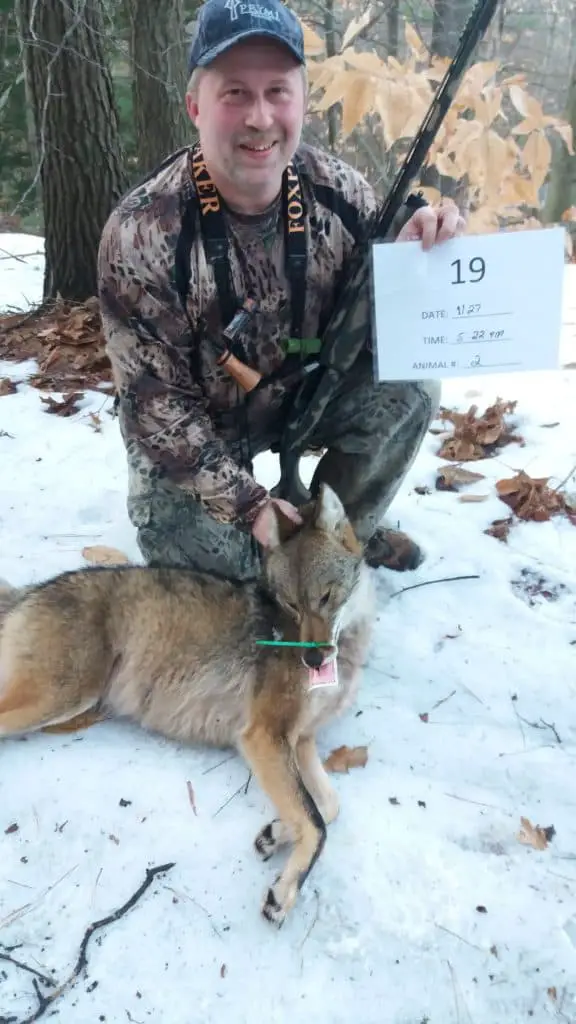
Casey Wood is a West Virginia coyote hunter and the owner of the Coal Country Killers. He goes coyote hunting with a shotgun equipped with a Remington V3, Patternmaster Non-constricted choke, and Hevi-Shot Dead Coyote loads. He has the skill set to take coyotes at up to 70 yards with his rig.
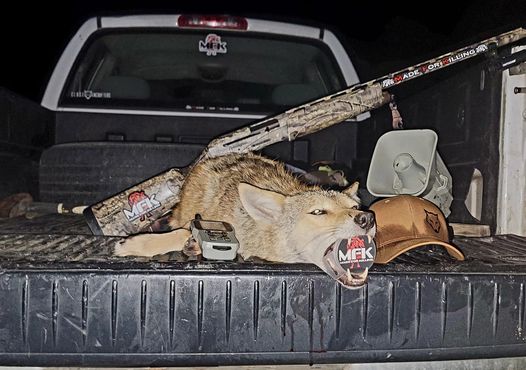
Russell Basalyga is a West Virginia coyote hunter that uses dogs. Russel runs a Remington 11-81 Super Mag with a Remington super full choke and shoots Winchester 3 1/2” #4 Buck. While he can put five bbs in the kills zone of a coyote at 50 yards, he cautions others his preferred choke is not designed to be used for this shell. If accuracy is important, it’s double essential when your dogs are out in front of the muzzle.
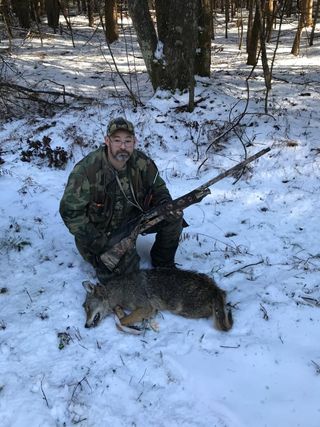
Michael Dement is one of those guys who, leaving a wife and kids at home in the States, put on a uniform and went to some bad places so that my family and yours could sleep peacefully at night. In the Army, he’s racked up a few shooting awards, and in his free time, more than a few coyotes. He uses a Winchester SX4 with a pistol red dot when hunting coyotes with a shotgun. Equipped with an Indian Creek Predator choke, he uses 3″ Remoington #4 buck or 3” Winchester Varmint-X BB loads.
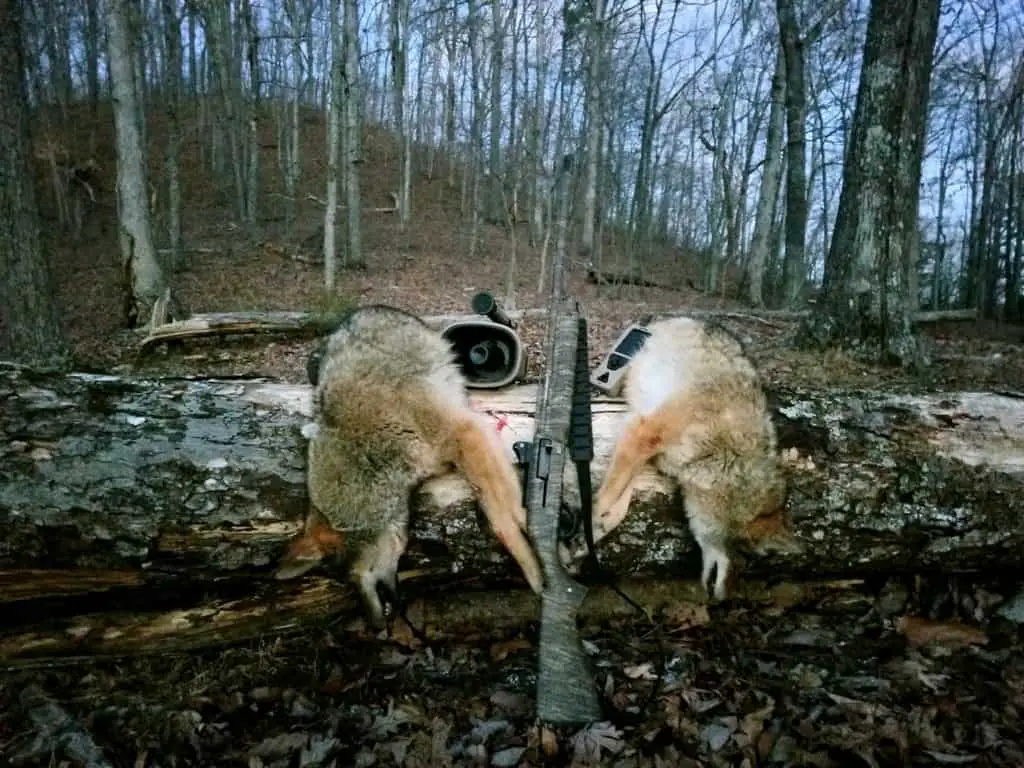
Calling tips when hunting coyotes with a shotgun.
Way back in 1944, ”decoying” (calling) coyotes was already a proven technique for luring coyotes.
“The squeak-call is made by forcing air into the mouth with the lips lightly closed or by placing the back of the hand against the lips and sucking air into the mouth. The noise thus created resembles the squeaking of a mouse. This squeaking noise is commonly used by ornithologists to decoy birds into a position where they may be watched or obtained for specimens.”
“The howl call is high-pitched and can be made with the mouth. The aim is to imitate the howl of a coyote. For those whose voices are not suitable for making this call, a hand siren can be used. This call has been used most successfully along with one of the other calls and is especially helpful in locating coyotes. After hearing this call, coyotes, especially in fall, winter and early spring months, often begin to howl or bark which reveals their location to the hunter, who can then approach closer and use the more effective distress call.”
Today, 80 years later, you can use the best closed reed rabbit distress call made by Rush Custom Callers to make a squeak call. I also strongly recommend you pick up the best open reed coyote howler on the market—also made by Brian Rush.
Author’s note: I have no financial relationship with Mr. Rush or his company. I receive no payment or other benefit from recommending his products. Simply put, buy them and you will take coyotes—when you do, please recommend both of us to your friends.
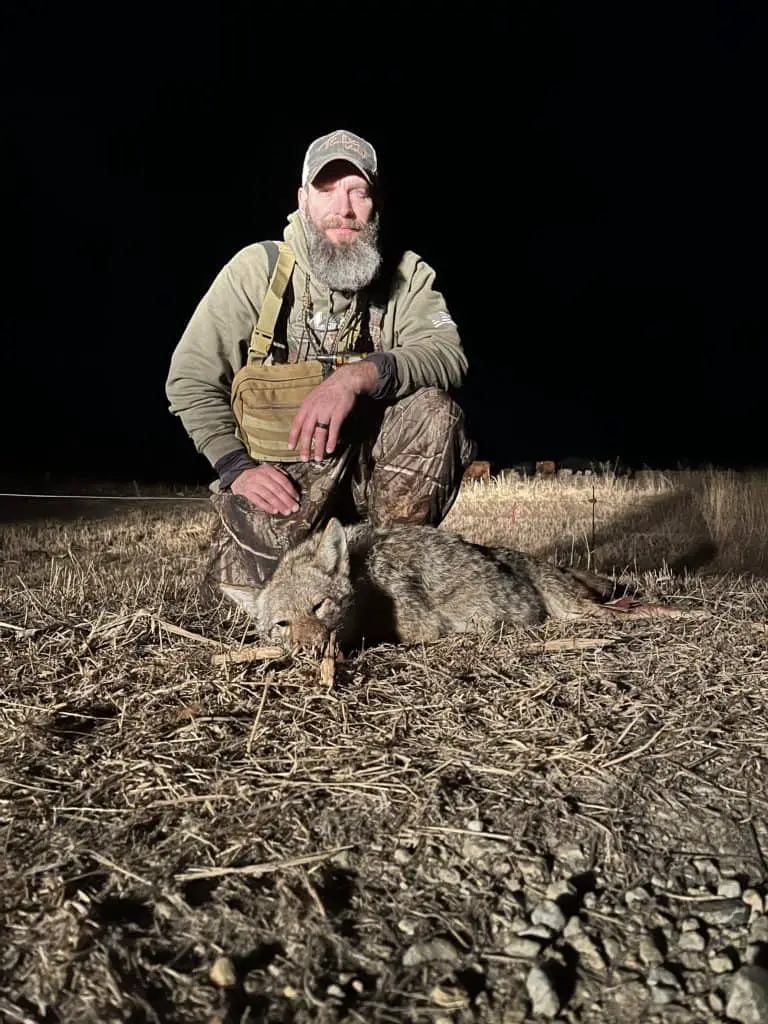
Calling coyotes into shotgun range.
If you want to learn how to use an open reed coyote call, check out this article and how-to video: 3 Open reed coyote calls you can learn now.
If you need to use a closed reed call tonight, check out, How to master the best closed reed caller.
The calls you use will depend on the season you are hunting. Here are a few in-depth articles to help you get started:
The secret calls your buddy use but do not tell you about.
Your first time using a shotgun to hunt coyotes.
You will see more success if you keep your range as short as possible. Learn to trust the calls you are using and learn to read the coyote’s body language to know when to pull the trigger.
But, before you head out into the field, spend some time realistically practicing. You’ll be ready then to take a coyote out the first time you go hunting coyotes with a shotgun.

